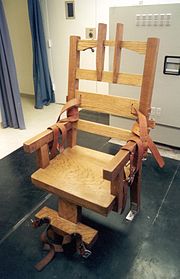
Back Elektriese stoel Afrikaans Ligetsetl ANG كرسي كهربائي Arabic Elektrik stulu Azerbaijani Електрически стол Bulgarian Cadira elèctrica Catalan Elektrické křeslo Czech Elektrisk stol Danish Elektrischer Stuhl German Ηλεκτρική καρέκλα Greek
The article's lead section may need to be rewritten. (April 2024) |

The electric chair is a specialized device employed for carrying out capital punishment through the process of electrocution. During its use, the individual sentenced to death is securely strapped to a specially designed wooden chair and electrocuted via strategically positioned electrodes affixed to the head and leg. This method of execution was conceptualized by Alfred P. Southwick, a dentist based in Buffalo, New York, in 1881. Over the following decade, this execution technique was developed further, aiming to provide a more humane alternative to the conventional forms of execution, particularly hanging. The electric chair was first utilized in 1890 and subsequently became known as a symbol of this method of execution.
The electric chair has been closely associated with the history of capital punishment in the United States and has also been utilized for a significant period in the Philippines. Originally, it was believed that death resulted from cerebral damage, but in 1899, it was scientifically established that the primary cause of death is ventricular fibrillation followed by cardiac arrest.
Despite its historical significance in the context of the American death penalty, the use of the electric chair has diminished over time due to the increasing adoption of lethal injection as a more humane method of execution. While certain states still retain electrocution as a legally authorized method of execution, it is often employed as a secondary option, contingent upon the preference of the condemned individual. Exceptions to this include South Carolina, where it is the primary method, and Tennessee, where electrocution can be used without prisoner input if the necessary drugs for lethal injection are unavailable.
As of 2024, electrocution remains a selectable method of execution in states such as Alabama, where inmates may opt for lethal injection instead, and Florida, where inmates may also instead opt for lethal injection, but electrocution can also be used if lethal injection is found to be unconstitutional. In contrast, Arkansas, Kentucky and Tennessee have the electric chair available for individuals sentenced to capital punishment before a certain date, who can choose electrocution. Inmates who do not select this method, as well as those convicted after the aforementioned date, are executed through lethal injection. Arkansas currently does not have any inmates on its death row, sentenced before their select date. All three aforementioned states have also authorized the use of electrocution as a potential alternative if lethal injection is deemed unconstitutional by a court.
The electric chair continues to be an accepted alternative method of execution in states like Mississippi and Oklahoma, to be utilized if other forms of execution are ruled unconstitutional at the time of the execution.
A significant turning point occurred on February 8, 2008, when the Nebraska Supreme Court ruled that execution by electric chair constituted a form of "cruel and unusual punishment" under the state's constitution. This decision marked the cessation of electric chair executions in Nebraska, making it the last state to rely solely on this method of execution.
© MMXXIII Rich X Search. We shall prevail. All rights reserved. Rich X Search